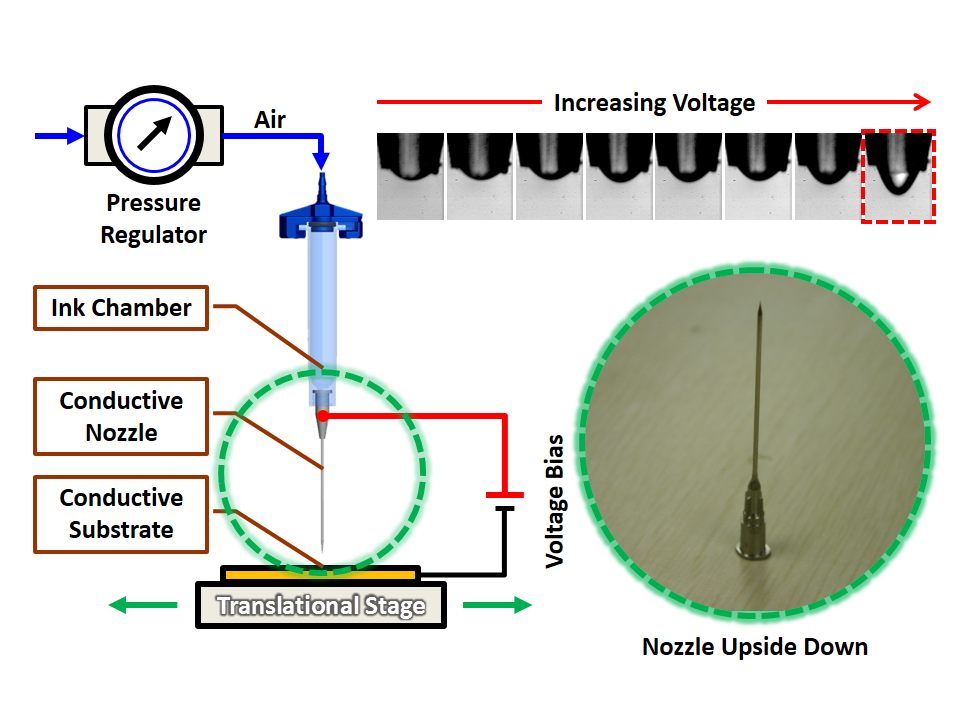The following ARG students are currently conducting research in the field of micro/nano scale manufacturing control.
Other Research Areas:
Electrohydrodynamic Jet Printing
Nano and micro-manufacturing has emerged as a critical component of nano and micro systems technology. Along with an increasing variety of available materials comes a need for increasingly sophisticated manufacturing platforms capable of utilizing said materials at higher and higher levels of resolution. Electrohydrodynamic jet (E-jet) printing uses an electric field to induce fluid flows from micro capillary nozzles to create devices in the micro/nano-scale range.The figure below presents the basic components of an E-jet printer and the video showcases the camera view (10x) of the E-Jet printing process in real time fashion.
E-Jet printing has emerged as a high resolution alternative to other forms of direct solution-based fabrication approaches, such as ink-jet printing. The diameter of an E-Jet Printed droplet ranges from several hundreds of nanometer up to a few microns. Depending on the application, E-Jet printer can either produce discrete droplets or continuous lines. In the past decade, there has been various application for E-Jet printing, primarily for biosensing and printed electronics application. Journal Publications
Journal Publications
- E. Sutanto, Y. Tan, B.T. Cunningham, A.G. Alleyne, “Multimaterial E-Jet Printed Micro-optical Devices”, Manufacturing Letters (submitted)
- Y. Tan, E. Sutanto, A.G. Alleyne, B.T. Cunningham, “Sensitive Fluorescent Homogeneous Assay Using Photonic Crystal Enhanced Fluorescence in an E-jet Printed Submicron-channel”, Biophotonics, 2013 (submitted)
- M. S. Onses, C. Song, L. Williamson, E. Sutanto, P.M. Ferreira, A.G. Alleyne, P.F. Nealey, H. Ahn, J.A. Rogers,”Hierarchical Patterns of Three Dimensional Block-Copolymer Films Formed by Electrohydrodynamic Jet Printing and Self-Assembly”, Nature Nanotechnology, 2013. (Link)
- K. Shigeta, Y. He, E. Sutanto. S. Kang, A.P. Le. R.G. Nuzzo, A.G. Alleyne, P.M. Ferreira, Y. Lu, J.A. Rogers, “Functional Protein Microarrays by Electrohydrodynamic Jet Printing”, Analytical Chemistry, 2012. (Link)
- E. Sutanto, K. Shigeta, Y.K. Kim, P.G. Graf, D.J. Hoelzle, K.L. Barton, A.G. Alleyne, P.M. Ferreira, J.A. Rogers, “A Multimaterial Electrohydrodynamic Jet (E-Jet) Printing System”, Journal of Micromechanics and Microengineering, 2011. (Link)
Conference Publications:
- E. Sutanto, A.G. Alleyne, “Iterative Learning Control for 2-D Image Based Visual Servoing Application”, in American Control Conference, 2014. (Submitted)
- Y. Tan, E. Sutanto, A.G. Alleyne, B.T. Cunningham, “Photonic Crystal Enhancement of a Homogeneous Fluorescent Assay using Submicron Fluid Channels Fabricated by E-jet Patterning”, in SPIE BiOS, 2014 (submitted)
- E. Sutanto, A.G. Alleyne, “Norm Optimal Iterative Learning Control for a Roll to Roll Nano/Micro-Manufacturing System”, in American Control Conference, 2013. (Link)
- E. Sutanto, K. Shigeta, K.L. Barton, A.G. Alleyne, and J.A. Rogers, “A High Throughput Electrohydrodynamic Jet System,” in ISFA, St. Louis, 2012. (Link)
- E. Sutanto, K. Shigeta, D.J. Hoelzle, A.G. Alleyne, and J.A. Rogers, “Micropositioning of a Multimaterial Electrohydrodynamic Jet Deposition System Using Vision Feedback,” in Dynamic System and Control Conference, Arlington, 2011. (Link)
- P.G. Graf, E. Sutanto, K.L. Barton, A.G. Alleyne, and P.M. Ferreira, “High-Resolution Electrohydrodynamic Jet Printing System,” in North American Manufacturing Research Conference , Corvallis, 2011. (Link)


